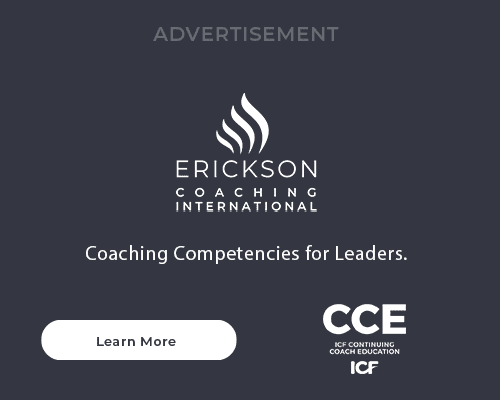A Coaching Approach to Identifying Your Ideal Clients
First off, thanks so much for all of your tweets, retweets, shares, emails and virtual tea after my Feb 6th post on “The Coaching approach to Business Development for Coaches.” What an incredible response. What I heard was you liked the format – with coaching questions you could reflect on – and the topic. I loved hearing you laugh as you said “Yeah, that’s me,” seeing you smile as you told me you identified with the challenge (the vulnerability that arises when you are the product and you have to ask others to consider you to be their coach). I also love that you are committed to getting beyond it and building your business.
I have enjoyed virtual tea chats via Skype with coaches from around the world—Russia, Hungary, Canada, the US, and even Australia and China. We are united in our cause to support our clients in transforming their leadership and their lives. And we are united in our challenges.
So I thought I’d start a series for you. In each post I’ll focus on a new topic, centered on business development with a focus on authenticity: aligning everything you do in your business to who you are and what your values are.
I’ll use a coaching approach format for you (because that’s what you have said you like) and I’ll address topics such as how to identify your ideal clients (today’s topic), plus others such as how to price your offerings, how to use social engagement to support your active marketing strategy, and how to diversify your offerings to build a sustainable business. If you have a topic you would like me to share my experiences about, please email me at Tana@LeadAuthentic.com and I’ll add it to the list.
So on to today’s topic: choosing and focusing on your primary clients.
When I ask the question – who is your ideal client? What I hear, after the long thoughtful pause, is “I don’t really know who my ideal client is” or “I want to help everyone.” Even considering the idea of having to say no to some clients in order to focus on others can be incredibly uncomfortable.
The thing about us coaches is many of us are optimists. We sincerely want to support many, many people and it may feel selfish, or that we are missing out, if we have to choose.
Well, it’s time to choose.
Time to put a stake in the ground and focus—focus everything you do on identifying, understanding and supporting that client group.
Your potential clients need to find you in order to build a successful business. In order for them to find you, and to see themselves in your offerings and communications to them, they have to be able to connect the dots to their life, their dreams, their leadership challenges, and their pain points. If they can’t, they may get confused about who you are and what you offer, or they won’t be able to differentiate you from other coaches.
Here are some coaching questions you can ask yourself to identifying your primary client (OK, you can a secondary client group as well). Does that make it a bit more fun?
Think of your primary client group as those who you can serve who are interested in coaching and have the funds personally or through their businesses to pay you what you are worth. Your secondary client group (not to be confused with less important—just a second group you want to target) may be another similar audience, or a group who you want to support and who may not be able to afford your fees. The primary clients (e.g. corporate) can subsidize your secondary group (e.g. teen girls).
I’ve put these questions into four buckets in the order they need to be asked. First is getting the right mindset to support focus, second is somatic support (shifting your experience in the body in order to support a new way of being), third is to set up the business rigor and discipline that is required for focus, and the final bucket is learnings and celebration.
1. Right Mindset
How do you think about focusing your business on one (or two) client groups?
Do you have any self-limiting beliefs that may be getting in your way?
How could you reframe how you think about focusing that would support you to be more effective? How could you reframe it to go one step further – to enjoy it and have more ease?
Who could you get support from in order to shift these beliefs if you are unable to shift them yourself?
What can you do to support yourself to stay focused?
What will it look like – what do you envision – when you have a full schedule of coaching clients?
2. Somatic Support (Right Body Language)
What occurs for you in the body when you think about focusing all your efforts on one (or two) client groups?
What occurs for you in the body when you are triggered by the idea of missing out on supporting other client groups?
How does it feel when you imagine attracting your primary client group with ease because they can relate to you, and you to them, and they are just waiting for you to enroll them as clients?
How could you shift your body language, in the moment, to distract your mind and to feel more comfortable with the idea of focus? Have you learned about the ABC’s of self-managing? How often are you practicing this each day?
3. Business Discipline and Rigor
How do your values provide guidance for who your primary client group might be?
What is your Why? (the deeply held reason, beyond the money, that taps into your emotions, for why this work is important to you).
What in your life has led you to be a coach? How can this guide you to your primary client group?
What expertise and experiences have you gained in your career and life that are relatable to your clients? That will support you in relating to them? Note: While this isn’t essential for coaching, it helps immensely in marketing effectively.
Can you put a name and face to your primary clients? Someone you have worked with or would like to work with who embodies the qualities and challenges of your primary clients? Do they have access to the funds to pay your fees? (If not, they may be your secondary client group).
How would you describe, in detail your primary client “Avatar”?
How can you use the questions above to clearly define your secondary client group?
How will this guide your website design and wording? Your offerings? Your communications? Your social strategy? Your business structure?
4. Learnings and Celebration
How do you listen and get feedback from your clients? What are you learning from them each year? How do you evolve your business in response to their feedback?
What are you learning about yourself and who you want to support? How will you apply what you are learning?
How do your values provide guidance for how you would like to celebrate?
What are you grateful for about your growing ability to focus your business?
What is going well? How will you celebrate your success?




Tana – Thanks for sharing. Somatic support is the practice that resonates most with me. In coaching conversations, this piece uncovers layers of insight. This is something that is hard to become aware of and keep in the forefront – the tendency is to push or ignore.
Robust reminders to all of us who work in this space because the clearer we answer the questions you raise here for ourselves, the sharper our work and the more compassionate, as we work with our clients.
Thanks,
Sunitha
[…] does your renewed personal clarity provide guidance for who your primary client group might […]
[…] base, initial steps include naming your business, defining your coaching niche, and describing your ideal client. Identifying your ideal coaching client sometimes occurs before choosing a business name or […]